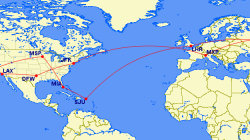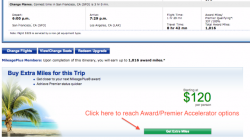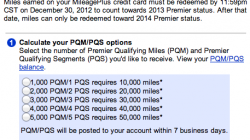We are nearing that time of year when people become desperate for mileage runs to maintain their elite status. Half of you might be running around like a chicken with its head cut off, grateful for some of the great deals that popped up Tuesday morning. The other half are probably wondering why anyone does this in the first place. Couldn’t you just fly the cheapest carrier and use the savings to upgrade when you want?
Yes… but that’s not the only benefit of elite status, nor is it necessarily the most valuable one.
Much of my travel is mileage runs, or other normal travel that has been adapted to mileage runs. It breaks down roughly like this:
- 25,000 miles of essential travel (see family, some work/school)
- 25,000 miles of non-essential travel (e.g., vacations, see friends)
- 50,000 miles of mileage runs (i.e., “Why are you doing this?”)
I’m doing this for three reasons: elite convenience benefits, elite upgrade benefits (domestic and international), and the opportunity for earning miles cheaply and redeeming them at a high value. This last one is where a successful mileage runner can really justify traveling as much as time will allow.
Convenience Benefits
Lots of people say air travel sucks. Why? Because of the lines, the cancellations, the disgruntled employees, etc.
I can’t say they’re wrong; even domestic first class has its issues, but my travel experience is certainly not like that of most people. I’m on a mileage run as I write this. I passed through the priority security line at the airport and utilized TSA’s PreCheck program to get through in less than five minutes, removing only my cell phone from my pocket. I later boarded through the Priority Access lane without waiting in line at all.
Had I checked a bag, the fees would be waived for up to three items for every person in my itinerary, and in theory the priority bag tags would mean they get delivered first upon arrival. Had there been a delay or cancellation in my itinerary, I would have had priority standby for reaccomodation on another flight. And had anything else gone wrong, I would be more likely to receive some kind of compensation for writing a complaint letter.
The savings from waived cancellation and change fees, waived baggage fees, and the ability to get through the airport faster could be valued at a few hundred to over a thousand dollars a year, depending on how much you travel. For those who are just shy of low-level elite status (25K miles a year), I think one mileage run is worth it.
Domestic Upgrade Benefits
I was upgraded for this flight 96 hours before departure. United has recently changed its upgrade policy so that complimentary upgrades are a bit harder to get, but I still do pretty well.
When I fly with Megan, she gets an upgrade, too. This used to be easier under the old United, but it still happens on a fair number of trips.
Each airline has its own rules for upgrades. For example, American Airlines only provides unlimited complimentary upgrades to their top-tier (100K miles) Executive Platinum members. Lower tiers receive upgrade coupons as they travel that can be redeemed for specific flights. This means you stand a better chance at upgrading only the flights you really want.
The domestic upgrades are largely a bonus for me. I would only value them at $10-20 per segment. But for those who might otherwise be willing to pay to sit up front, they are far more important.
International Upgrade Benefits
Systemwide upgrades can be a very valuable benefit. United offers its Premier 1Ks (also 100K miles) six Global Preferred Upgrades that can be used on any flight booked with a mid-priced economy or business class ticket. An additional four Regional Preferred Upgrades have no fare restrictions but can be used on domestic and certain international flights. (GPUs have no fare restrictions when used on this subset, so you could also think of it as 10 RPUs).
American offers its Executive Platinum members eight eVIP upgrades that can be used on any flight with no fare restrictions. There is no distinction between GPUs and RPUs like with United. But as I pointed out, United technically offers more total upgrades if you only use them only on domestic and certain international flights eligible for RPUs.
Delta offers elite choice benefits, which include four systemwide upgrades for its Platinum Medallion members (75K miles) and another six upgrades upon reading Diamond Medallion status (125K miles). But these upgrades are virtually worthless unless your employer purchases full fare tickets since they have heavy restrictions; it’s sometimes cheaper to buy discounted business class fares.
Depending on your airline of choice, whether you do any international travel, how much you value a premium cabin, how much of your travel is reimbursed by an employer, and whether you are booked in a premium cabin from the start, the value of these upgrades can range from nil to a couple thousand dollars.
Rebate Value of Redeemable Miles
As you progress through the elite tiers, you’ll earn more and more redeemable miles—not just because you’re flying more but because you get bigger bonuses on those miles. Usually the bonus is a measly 25% for a lower tier and 100% for a mid- or upper-level tier, but United has introduced more gradual changes so that mid-level elites only earn 50% or 75%.
These redeemable miles are separate from the elite qualifying miles that contribute toward status. You generally earn more of them and faster. They are the same kind you earn from credit cards and other promotions.
There are lots of easy ways to redeem miles for about a penny each. Easy and wasteful. If I put in some effort to find a good award flight, I should be able to get much more than a penny. For example, a domestic saver award in economy costs 25,000 miles. It’s not hard to find domestic tickets for $250 to many places, so I buy those, and I earn more miles doing it. I won’t redeem for a domestic ticket unless it costs $500 or more, a value of 2 cents per mile (CPM).
For travel to international destinations or in premium cabins, cash fares tend to rise much faster than the number of miles required, so the redeemable value of the miles is actually higher. But I stick with 2 CPM. I wouldn’t pay $10,000 for a first class ticket. But I might spend $2,000. Or I could redeem about 100,000 miles. See? It still works out to 2 CPM.
I aim for an average cost (across all my travel) of 4 CPM flown, which means I’m earning redeemable miles at a rate of 2 CPM. Hey! That’s the same price at which I value them when they get used.
Our trip to Asia cost 230,000 miles and $120 for two people. That’s pretty much all of the miles I earned from flying United in 2011 (100K flown x 100% bonus + a few promotions). Two economy class tickets would have easily cost $2,000 to $3,000 for our itinerary. Let’s average it at $2,500 for two people.
That’s my rebate for 2011. If I spent $4,000 to fly 100,000 miles and got a $2,500 rebate, my final cost for all those paid flights, including the mileage runs but also for vacations and visiting family, was only $1,500.
But I wouldn’t have earned all those miles if I flew less. If I only flew the 25,000 miles in essential travel, I would have earned 31,250 redeemable miles, a $625 rebate. And because essential travel tends to be less flexible, with expensive destinations and busy holiday dates, my cost to earn those miles would probably be much higher. The more mileage runs, the lower the average cost, and the higher the final rebate.
Conclusion
Despite this rebate talk, I’m still spending $4,000 a year. I’m okay with that because I’m stretching it awfully far. Another good excuse is that it’s a hobby. It’s an expensive hobby, but one that I can pay for because of other sacrifices. Some people pay a hundred dollars for sports or concert tickets. Some people go clubbing. Some people subscribe to cable or satellite television. It all adds up. I just choose to use my money for something else. I like to fly. 😉





